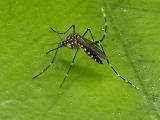"We're seeing a change in the nature of the yellow fever outbreaks we're dealing with."
That's how Bruce Aylward, M.D., World Health Organization (WHO) interim executive director of outbreaks and health emergencies, began a briefing today on yellow fever in which he discussed the current outbreak in Angola and the Democratic Republic of the Congo (DRC) and what's being done to address it.
Aylward said the WHO is going to launch a massive vaccination campaign over the next 2 months, using diluted doses and vaccines donated from Brazil to inoculate 15.5 million in the border areas between Angola and the DRC and in Kinshasa. This is in addition to current vaccine efforts being made near outbreak areas.
Vaccination must be swift
The scale of the vaccine campaign is unprecedented, Aylward said. Since January, when yellow fever first appeared in Luanda, Angola, 14.5 million people have been vaccinated in that city and surrounding areas.
The campaign launching this month will bring the total number of vaccinated people to 30 million. Aylward said the WHO, in collaboration with Gavi, the Vaccine Alliance, Angola, and the DRC, needs to work fast to vaccinate during the dry months, when mosquito populations are down.
"We have a 2-month window to belt this thing," he said.
"I often see in the press that the problem is that there's not enough vaccine," said Aylward. "That's not the problem; the problem is that the vaccine is not used effectively enough or fast enough to stop the outbreak."
Twice vaccine efforts in the past 6 months have drained the global stockpile of the yellow fever vaccine, which usually stands at 6 million. Aylward said that, to cover the targeted populations, diluted vaccines, one-fifth the standard dose, will be used in urban areas, along with 5 million donated vaccines from Brazil. Yellow fever is endemic in Brazil but not currently a threat to public health.
"Our primary focus is Kinshasa; we want 8 million people vaccinated in August," said Aylward. Three million people in anterior Angola and 4.3 million along the DRC-Angola corridor will also be vaccinated.
The cost of the campaign is $34 million. Aylward said $14 million is currently available from Gavi and vaccine donations, but the gap of $20 million will have to be filled by donors. The governments of Angola and the DRC are expected to shoulder much of the cost, as well.
The vaccine is inexpensive, about $1 to make and $1.50 to administer, according to the WHO. Alyward said adults in urban areas like Kinshasa are the best candidates for diluted doses, which would offer protection for at least 1 year. Children, he said, should still get the full vaccine dose, because fractioned dosing hasn't been tested on that population.
Earlier this week, Reuters reported there was a syringe shortage in Kinshasa. Alyward explained that the shortage was misrepresented: Diluted yellow fever vaccine doses need to be administered with a smaller needle, as they are given subcutaneously and not intramuscularly. WHO estimates it will have enough of the smaller syringes by August.
Changing epidemiology
Aylward said the current outbreak is "a clarion call" to rethink strategy on yellow fever control.
Yellow fever is a mosquito-borne hemorrhagic virus, endemic in 47 countries. Thirty-three of those countries are in Africa, with the rest in Latin America.
In 2006, countries in West Africa began a yellow fever vaccination campaign that was successful at getting 100 million children aged 9 months to 2 years vaccinated, as well as the rural populations who lived near the primates that host the disease. The problem, Aylward explained, is that yellow fever is no longer a rural disease, and the children who've been vaccinated haven't yet contributed to population, or herd, immunity.
"There's no evidence of change in virus," said Aylward. "What we're seeing is a changing world." Aylward said the rapid urbanization of Africa over the last 10 years and increased movement and mobility of people have made routine rural vaccination programs ineffective.
Most people who've contracted the disease during this outbreak are middle-aged, too old to have benefited from last decade's vaccine efforts and too young to have gained immunity through exposure.
As of this week, the WHO has reported 3,552 cases in Angola, with 355 deaths. The DRC reports 1,300 cases.
Noting that there have been only 10 deaths from yellow fever in the past 2 weeks, Aylward said the low mortality rate wasn't surprising, as both Angola and the DRC have had an active response to the outbreak.
Surveillance to prevent international spread
While international spread is a concern to the WHO, the fact that yellow fever has not traveled beyond the outbreak zone since April is somewhat reassuring, Aylward. In March, 2 cases of Angolan yellow fever appeared in Kenya. In April, 11 guest workers traveled from Angola to China and came down with the disease.
Heightened surveillance, especially along land borders, will be key to preventing the spread of yellow fever, Aylward said. He applauded Brazil, a country with endemic yellow fever, for donating its vaccine supply, adding that guarding vaccine stockpiles in countries where there's no current outbreak is not helpful.
Increased cases in the Americas
In other yellow fever news, the Pan American Health Organization (PAHO) released an epidemiologic update today on cases in Brazil, Colombia, and Peru. These cases are not related to the outbreak in Angola.
According to the report, Peru now has 106 suspected cases, 42 of them confirmed, and 9 deaths. The number of cases in that country is now more than the number of cases in the last 9 years combined. Most cases (58) have been in Junin department.
Brazil has a confirmed case in an area where the disease is endemic and where there were recent monkey illnesses. Colombia is increasing vaccine coverage in the three municipalities near recent jungle outbreaks in non-human primates.
See also:
Jul 7 PAHO report























